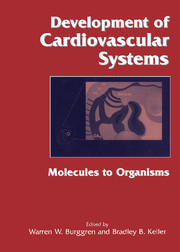Book contents
- Frontmatter
- Contents
- List of contributors
- Foreword by Constance Weinstein
- Introduction: Why study cardiovascular development?
- Part I Molecular, cellular, and integrative mechanisms determining cardiovascular development
- Part II Species diversity in cardiovascular development
- Part III Environment and disease in cardiovascular development
- Epilogue: Future directions in developmental cardiovascular sciences
- References
- Systematic index
- Subject index
Epilogue: Future directions in developmental cardiovascular sciences
Published online by Cambridge University Press: 10 May 2010
- Frontmatter
- Contents
- List of contributors
- Foreword by Constance Weinstein
- Introduction: Why study cardiovascular development?
- Part I Molecular, cellular, and integrative mechanisms determining cardiovascular development
- Part II Species diversity in cardiovascular development
- Part III Environment and disease in cardiovascular development
- Epilogue: Future directions in developmental cardiovascular sciences
- References
- Systematic index
- Subject index
Summary
The preceding 21 chapters have provided a broad overview to improve the reader's grasp of the molecular, cellular, and integrative mechanisms determining cardiovascular development across a diverse range of species, with a focus on the impact of environment and disease on heart development. The question now remains, Where do we go from here? In all the chapters, the authors have attempted to outline the limits of current understanding and to highlight areas of future investigation. Several common themes deserve reinforcement, perhaps coming together in full force only after a complete review of the text.
Species diversity provides a unique basic science paradigm for developing and testing novel hypotheses regarding the mechanisms that determine cardiovascular morphogenesis. Nature provides a wide range of elegant biological methods to solve specific structurefunction problems, one obvious example being the ability to shunt blood flow from the developing skin to lungs on transition to air-breathing. Invertebrate and nonmammalian cardiovascular systems are every bit as complex and adaptable to alterations in environmental forces as the popular “mature-mammalian” model for the cardiovascular system.
A multilevel analysis of cardiovascular development must be pursued for individual models. Coincident structural and functional maturation occurs at the subcellular, cellular, tissue, and organ levels during heart development in all species. It is not sufficient to limit developmental investigations to a single analysis plane, and we must define developmental mechanisms from the initial expression of DNA coding through the topological distribution of macromolecules into the mature 3-dimensional structure. In many instances, this multilevel analysis will demand both high technology and high cost, and each individual investigator will possess only a subset of the needed tools and skills.
- Type
- Chapter
- Information
- Development of Cardiovascular SystemsMolecules to Organisms, pp. 285 - 286Publisher: Cambridge University PressPrint publication year: 1998



